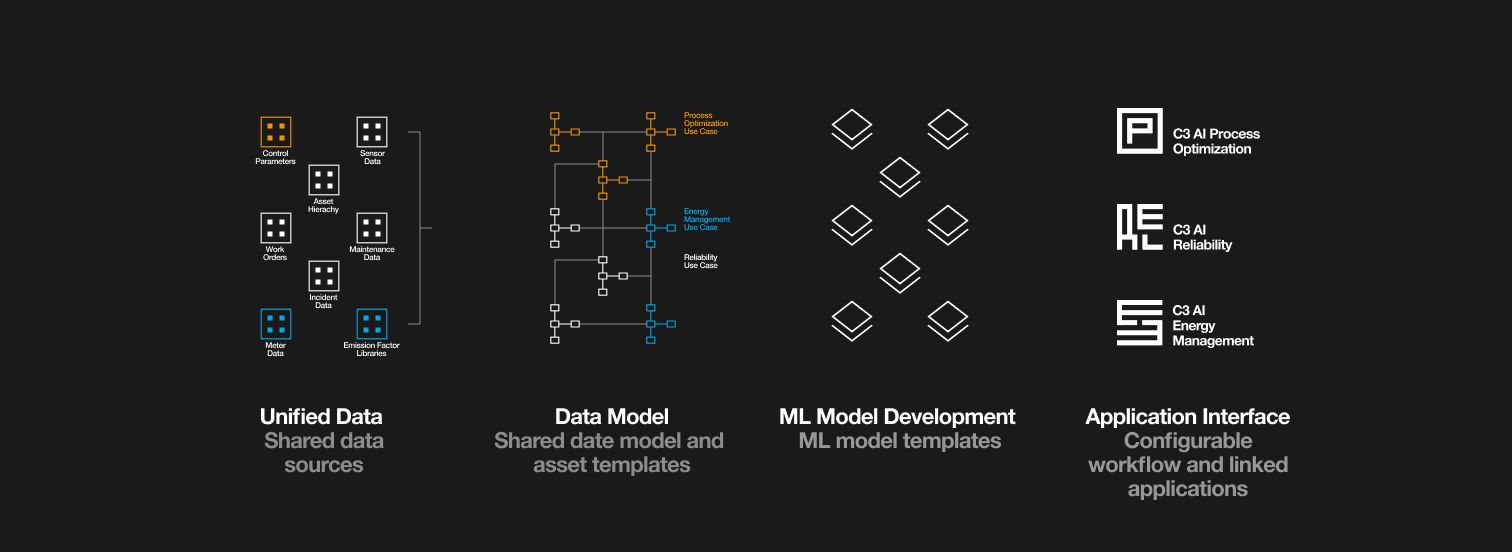Learn how AI-powered asset performance solutions can increase overall equipment effectiveness by up to 5%, increase revenue, and decrease expenses
By Timothy Holtan, Senior AI Solution Director, C3 AI
Early asset performance management (APM) solutions from the 2000s promised increased asset reliability, decreased maintenance expenses, and increased profits — and industries driven by economies of scale including oil and gas, power generation, and commercial aviation were quick to adopt these new technologies. But soon organizations realized early asset performance management solutions fall short and don’t address the most business-critical ask: delivering predictive analytics rather than descriptive reporting. Now with AI-powered asset performance management solutions, enterprises can achieve accurate, powerful predictive maintenance that will reduce costs and improve efficiency.
Organizations Are Plagued by the Cost and Functional Limitations of Legacy APM Solutions
Early asset management systems focused on historical data — tracking lagging indicators like mean time between failures (MTBF), asset integrity, work orders, vibration, and functional failures. Monitoring services offered by original equipment manufacturers notified customers only after a failure has occurred and offered expedited replacement parts. They didn’t deliver what customers actually wanted: early warnings of equipment issues and guidance on how to avoid equipment shutdowns.
The addition of threshold-based analytics improved troubleshooting and provided the first version of asset performance solutions for asset operators. However, these analytics needed extensive manual data entry and input from subject matter experts. Customers found these analytics difficult to maintain at scale and did not adopt them broadly.
Nonetheless, over time, industrial organizations invested millions of dollars upgrading legacy computerized maintenance management (CMMS), enterprise asset management (EAM), and asset performance management (APM) solutions to alleviate the high costs of unplanned downtime and maintenance. Yet due to the limitations of these systems, non-productive time and high maintenance costs persisted.
Backwards Focused
Focused on displaying and explaining issues and damage that have already occurred
Limited Analysis
Limited to a few data types such as mean time between failure, vibration data, or lube oil analysis
Limited Modelling
Lacked flexibility to combine machine learning and engineering models or limited to specific models
Dependency on Experts
Relied on experts who are in short supply to generate recommendations for one- dimensional analyses
Despite investing heavily and setting ambitious goals for improved operations, industrial organizations suffered lost profits and high sunk costs as early analytical software solutions failed to deliver on promises. Today, industry seeks a new approach to deliver faster, more scalable, more accurate, and more actionable insights to increase asset utilization and availability. But new challenges have emerged in an already complex environment.
To deliver on these goals, a differentiated asset performance management solution must enable asset operators to overcome three core challenges:
- Aging Assets: Extended equipment lifecycle increase maintenance needs Declining Capital Expenditures: Decreased investments despite aging assets Shrinking Workforce: Decline in industrial workforce amidst rising expectations
Asset Management Challenge #1: Aging Assets
The industrial base of capital-intensive industries is aging. According to the Bureau of Economic Analysis, the average age of fixed assets has increased by an average of 21% across industries since 2015. Since older assets require more maintenance per year, shifting required maintenance from unplanned to planned alleviates the increased maintenance workload and costs.
Asset Management Challenge #2: Declining Capital Expenditures
Despite the aging asset base, capital expenditures continue to decrease. A study from NYU Stern School of Business shows that the capital expenditures in the U.S. oil & gas industry has decreased on an average of 55% from 2014 to 2023. As maintenance demands for aging assets continues to rise, new assets are either slow to arrive or unavailable to replace the aging installed base.
Asset Management Challenge #3: Shrinking Workforce
To add on to the challenge, the industrial workforce continues to shrink. The U.S. Bureau of Labor Statistics shows that the U.S. industrial workforce decreased by more than 40% since 2014. Industrial companies must do more with less and empower the existing workforce to become more efficient.
Industrial organizations require a new approach with an advanced asset performance management solution to address new asset management and profitability challenges.
Requirements for New AI-Powered Asset Performance Solutions
To stop the cycle of persisting asset management challenges, industrial managers need asset management solutions that can:
- Unify all data including sensors, work orders, reliability analyses, and equipment manuals together into a single source of truth. Predict functional failure early and be able to act quickly. Monitor all assets across rotating and fixed equipment and multi-unit operations. Scale quickly, from a single piece of equipment, to across one plant, to an entire enterprise.
The Benefits of AI-Powered Asset Performance Solutions
With AI-powered asset performance management solutions, industrial management can achieve the desired cost reduction and efficiency improvements by utilizing data and predictive models at unprecedented scale.
Integrate
- Time series data (e.g., AVEVA, Honeywell) Vibration analysis data (e.g., Bently Nevada, SKF) Laboratory data Work order data (e.g., SAP, IBM) P&ID diagrams (e.g., Dassault) Equipment data sheets (e.g., Worley Parson, Siemens) Reliability-centered analyses (e.g., Baker Hughes ARMS) Maintenance cost data (e.g., Oracle)
Predict
- Degradation rates of critical equipment based on near real-time performance Failure timing of critical equipment Characterization of incipient failure modes Recommended actions to address failure modes Process efficiency and yield gaps Process https://c3.aihttps://c3.ai/wp-content/uploads/2024/07/icon-linegraph-up.pngp>
Optimize
- Control setpoints to maximize throughput and profitability Feedstock mixture to maximize yield Reaction rate to optimize chemical composition Multiple constraints across process steps to satisfy production schedule requirements


